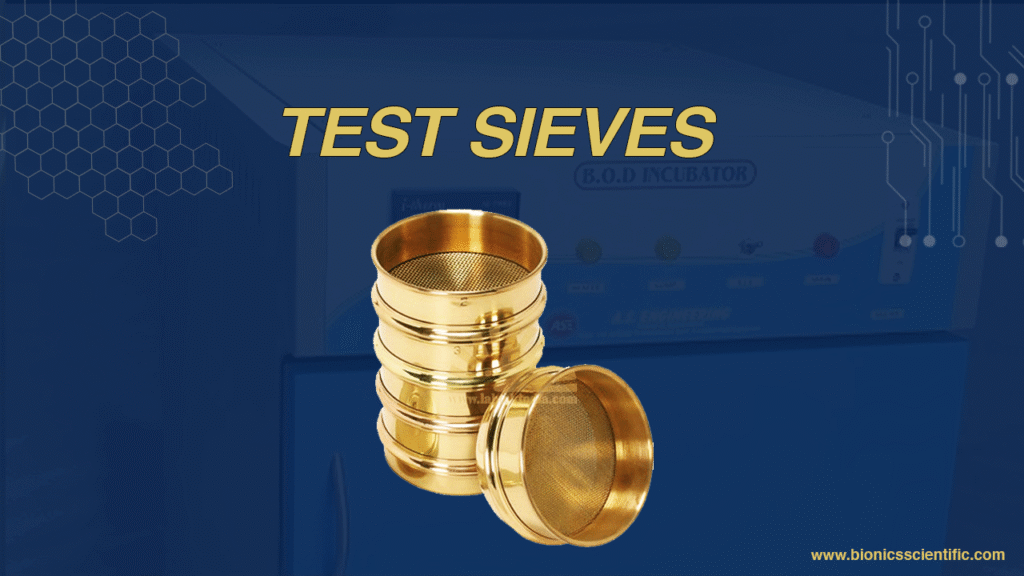Laboratory test sieves are tools used to separate and classify materials by particle size. They play a key role in quality control and material analysis in many industries. This post explains how they work, what types are available, and how to use and maintain them.
- What Is a Test Sieve?
- Why Test Sieves Matter
- Main Components of a Test Sieve
- Mesh Size Explained
- Common Mesh Sizes and Applications
- Types of Test Sieves
- Sieve Standards
- How to Perform a Sieve Analysis
- Manual vs Mechanical Sieve Shaking
- Care and Maintenance
- Common Issues and Fixes
- Test Sieves in Different Industries
- How to Choose the Right Test Sieve
- Digital Sieve Analysis
- Certifications and Calibration
- Storage and Handling Best Practices
- Alternatives to Sieving
- Summary
What Is a Test Sieve?
A test sieve is a round metal frame with a mesh screen stretched across the bottom. The mesh has uniform openings and allows only particles of a certain size to pass through. Larger particles stay on the screen.
Test sieves are used in a process called sieve analysis. This helps determine the particle size distribution in a material sample.

Why Test Sieves Matter
Sieve analysis is critical for accurate and repeatable lab results. In fields like pharmaceuticals, food, construction, and mining, the size of particles affects product quality and safety. Test sieves help ensure consistency in these industries. Check this also: Sieve Shaker Working Video
For example, cement must meet size standards to ensure strength. In food production, texture and blend depend on even particle sizing.
Main Components of a Test Sieve
Each test sieve has three basic parts:
1. Frame The frame is usually made of stainless steel or brass. It holds the mesh in place and provides strength. Frames are circular, most often 8 or 12 inches in diameter.
2. Mesh (Screen) The mesh is the filtering part. It’s made from wire cloth with uniform openings. These openings are measured in microns or mesh number.
3. Backing (optional) Some sieves have a backing mesh to support fine screens. This reduces wear and extends life.
Mesh Size Explained
Mesh size is a count of how many openings fit in one inch of screen. A 100-mesh sieve has 100 openings per inch. The higher the mesh number, the finer the openings.
Another way to measure mesh is in microns. One micron equals one-thousandth of a millimeter. For example, 150 microns is a medium-fine size.
Check this also: Electromagnetic sieve shaker
Common Mesh Sizes and Applications
| Sieve Mesh Chart | |||
|---|---|---|---|
| Aperture Size | |||
| B.S.S (410/1969) | A.S.T.M (11-70) | I.S (469/1972) | Microns |
| 4 | 5 | 4.00mm | 4000 |
| 5 | 6 | 3.35mm | 3353 |
| 6 | 7 | 2.80mm | 2812 |
| 7 | 8 | 2.36mm | 2411 |
| 8 | 10 | 2.00mm | 2057 |
| 10 | 12 | 1.70mm | 4000 |
| 12 | 14 | 1.40mm | 1405 |
| 14 | 16 | 1.18mm | 1204 |
| 16 | 18 | 1.00mm | 1204 |
| 18 | 20 | 0.850mm | 850 |
| 22 | 25 | 0.710mm | 710 |
| 25 | 30 | 0.600mm | 600 |
| 30 | 35 | 0.500mm | 500 |
| 36 | 40 | 0.425mm | 420 |
| 44 | 45 | 0.355mm | 355 |
| 52 | 50 | 0.300mm | 300 |
| 60 | 60 | 0.250mm | 250 |
| 72 | 70 | 0.212mm | 210 |
| 85 | 80 | 0.180mm | 180 |
| 100 | 100 | 0.150mm | 150 |
| 120 | 120 | 0.125mm | 120 |
| 150 | 140 | 0.106mm | 105 |
| 170 | 170 | 0.090mm | 90 |
| 200 | 200 | 0.075mm | 75 |
| 240 | 230 | 0.063mm | 63 |
| 300 | 270 | 0.053mm | 53 |
| 350 | 325 | 0.045mm | 45 |
| 400 | 400 | 0.037mm | 37 |
| 500 | 500 | 0.025mm | 25 |
| Mesh Size | Opening (Microns) | Typical Use |
|---|---|---|
| 4 | 4760 | Gravel, coarse sand |
| 20 | 841 | Sand, soil |
| 60 | 250 | Cement, flour |
| 100 | 150 | Powdered chemicals |
| 200 | 75 | Pharmaceuticals, fine dust |
Types of Test Sieves
There are different sieve types based on the mesh and use case.
- Woven Wire Sieves: These are the most common. They use stainless steel mesh for precision screening. Used in labs and QC testing.
- Perforated Plate Sieves: Instead of mesh, they have punched holes in a metal plate. Suitable for coarse material and aggregates.
- Electroformed Sieves: Made by electroforming a nickel mesh. These offer high precision. Used for very fine particle testing, such as in pharmaceuticals.
Sieve Standards
To ensure consistent results, sieves must meet recognized standards.
Common Standards:
- ASTM E11 (U.S. standard)
- ISO 3310 (International standard)
- BS 410 (British standard)
Each defines mesh sizes, tolerances, and construction guidelines.
How to Perform a Sieve Analysis
Sieve analysis is simple but requires care. Follow these basic steps:
- Select Sieves: Choose sieves based on the expected particle sizes. Stack from largest on top to smallest at bottom.
- Weigh the Sample: Weigh the sample before placing it in the top sieve. Record this weight.
- Sieve the Sample: Use manual shaking or a sieve shaker. Shake for 5–10 minutes.
- Weigh the Fractions: Weigh the material left in each sieve. Record and calculate percentages.
- Report Results: Create a particle size distribution chart. Use the weights and mesh sizes to build a graph or table.
Manual vs Mechanical Sieve Shaking
- Manual Shaking: Done by hand or with a hand-operated device. Suitable for small labs or occasional tests. May be less repeatable.
- Mechanical Shakers: Machines that vibrate or rotate sieves. Ensure better accuracy and consistency. Used in large labs or production testing.
Care and Maintenance
Test sieves last longer when handled properly. Here are basic care tips:
- Clean after each use: Tap lightly and brush gently.
- Avoid bending the mesh: This can alter size openings.
- Store safely: Keep sieves dry and away from heavy objects.
- Check calibration: Periodically test against standards.
Common Issues and Fixes
| Problem | Cause | Solution |
|---|---|---|
| Inaccurate results | Worn mesh or poor technique | Replace mesh, retrain staff |
| Clogged mesh | Fine particles stuck | Use soft brush or ultrasonic cleaning |
| Uneven shaking | Manual error | Use a sieve shaker |
Test Sieves in Different Industries
- Construction: Sieves classify soil, sand, and aggregate. This helps ensure strength and stability in concrete and asphalt.
- Pharmaceuticals: Used to ensure uniform particle size in drugs and powders. This affects solubility and dosage.
- Food Industry: Ensures consistency in flour, spices, and dry mixes. Affects flavor, texture, and packaging.
- Chemicals and Powders: Sieves screen raw materials and final products. Keeps the quality and reactivity consistent.
How to Choose the Right Test Sieve
Use these criteria:
- Material Type: Select stainless steel for corrosion resistance. Brass is fine for dry, non-corrosive samples.
- Mesh Size Range: Choose mesh based on your material’s size. Use a series of 5–8 sieves for a full analysis.
- Compliance: Make sure sieves meet ASTM or ISO standards if you need certified results.
- Quantity: Decide how many sieves you need. A full set usually includes a lid and pan.
Digital Sieve Analysis
Some labs use digital particle analysis systems. These tools scan particles using imaging software. Results are fast and detailed. But they are costlier and not always necessary.
Traditional sieves remain the standard in many labs due to their simplicity and accuracy.
Certifications and Calibration
Certified test sieves come with documentation showing they meet accuracy standards. This is key in regulated industries like pharma or construction. Calibration involves checking a sieve’s mesh size against a known standard. Do this once a year or after heavy use.
Storage and Handling Best Practices
Store sieves in a dry cabinet or on a dedicated rack. Avoid stacking them without padding. Always label sieves by mesh size to prevent mix-ups. Handle gently. Don’t press down on the mesh or stack with force. Keep away from harsh chemicals unless the sieve is chemical-resistant.
Alternatives to Sieving
When sieving is not possible, other methods may be used.
- Laser Diffraction: Uses light scattering to measure particle size. Fast and precise, but costly.
- Sedimentation: Separates particles in a fluid by density and size. Suitable for very fine materials. Still, for many labs, test sieves remain the most accessible and reliable method.
Summary
Test sieves are simple yet powerful tools. They separate particles by size and help ensure material quality. Used across industries, they support consistent production, safety, and research. By selecting the right sieve, following good practices, and caring for the tool, you can trust the results every time.



